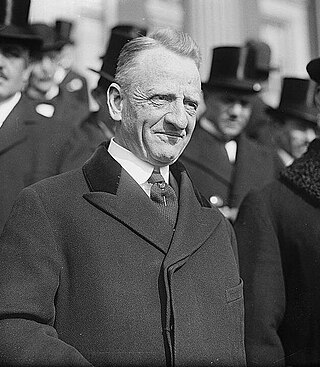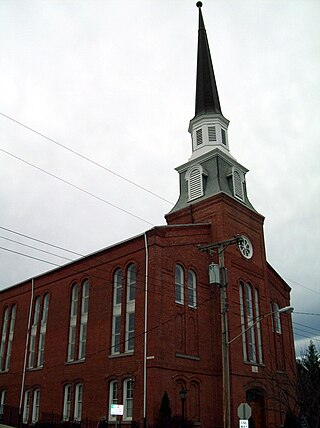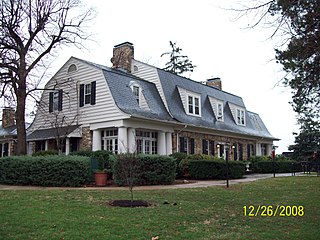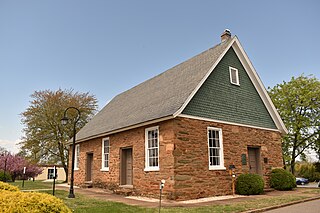The Glass–Steagall legislation describes four provisions of the United States Banking Act of 1933 separating commercial and investment banking. The article 1933 Banking Act describes the entire law, including the legislative history of the provisions covered.

Carter Glass was an American newspaper publisher and Democratic politician from Lynchburg, Virginia. He represented Virginia in both houses of Congress and served as the United States Secretary of the Treasury under President Woodrow Wilson. He played a major role in the establishment of the U.S. financial regulatory system, helping to establish the Federal Reserve System and the Federal Deposit Insurance Corporation.

The Second White House of the Confederacy is a historic house located in the Court End neighborhood of Richmond, Virginia. Built in 1818, it was the main executive residence of the sole President of the Confederate States of America, Jefferson Davis, from August 1861 until April 1865. It currently sits on the campus of Virginia Commonwealth University.

Green Springs National Historic Landmark District is a national historic district in Louisa County, Virginia noted for its concentration of fine rural manor houses and related buildings in an intact agricultural landscape. Admitted to the National Register of Historic Places in 1974, it became the first rural National Landmark Historic district. Named for one of the historic manor houses, the district comprises 14,000 acres (5,700 ha) of fertile land, contrasting with the more typical poor soil and scrub pinelands surrounding it.

The Anne Spencer House, in Lynchburg, Virginia, United States was, from 1903 to 1975, the home of Anne Spencer, a poet of the Harlem Renaissance. The house opened as a museum in 1977.

The tallest object on the downtown skyline of Lynchburg, Virginia, Court Street Baptist Church stands as a testament to the black Baptist population of Lynchburg. Organized in 1843, the congregation—originally known as the African Baptist Church of Lynchburg—was the first of its kind in the city. The church was designed by R.C. Burkholder, and completed in 1880.
The first "Glass–Steagall Act" was a law passed by the United States Congress on February 27, 1932, prior to the inclusion of more comprehensive measures in the Banking Act of 1933, which is now more commonly known as the Glass-Steagall Act. It was the first time that currency was permitted to be allocated for the Federal Reserve System. It was passed in an effort to stop deflation and expanded the Federal Reserve's ability to offer loans to member banks (rediscounts) on more types of assets such as government bonds as well as commercial paper.

The Allied Arts Building is a historic high-rise building located at 725 Church Street in Lynchburg, Virginia. It is currently being remodeled for apartments.

Montview, also known as the Carter Glass Estate, is a historic home located on the Liberty University campus at Lynchburg, Virginia. Then newly elected Senator Carter Glass, who had lived in downtown Lynchburg for many years in a house constructed a century earlier, directed this house's construction and moved in in 1923. It remained his official residence until his death in 1946. Although Senator Glass took his final oath of office on the glass-enclosed porch at Montview in 1943 and his funeral service was held on this estate, he physically lived his last years at the Mayflower Hotel in Washington, D.C.

Point of Honor is an historic home, now a city museum, located in Lynchburg, Virginia. The property has commanding views of the city and the James River. Its name originated due to the land on which it is built being used as a clandestine dueling ground.

John Marshall Warwick House is a historic home located at Lynchburg, Virginia. It was built in 1826 by prominent Lynchburg tobacconist and city mayor (1833), John Marshall Warwick. It was one of the first houses to be built on the crest of Lynchburg Hill, later to be called Court House Hill, overlooking the James River. It exhibits the transition from the Federal to the Greek Revival styles. His grandson, United States Senator John Warwick Daniel was born in this home.

Rosedale, a historic property comprising the Graves Mill ruins, Christopher Johnson Cottage, and Rosedale mansion, is located at Lynchburg, Virginia. The Rosedale property contains two buildings of major importance, the ruins of an 18th-century grist mill, and numerous subsidiary buildings. The earliest structure remaining is the Christopher Johnson Cottage, dating from ca. 1764 to 1774. The small, 1+1⁄2-story frame structure has long been known as the Johnson Cottage. The Rosedale mansion was erected in 1836 by Odin Clay, the first president of the Virginia and Tennessee Railroad, and is a two-story, three-bay, brick home laid in Flemish bond. The house was enlarged in 1929; a three-bay brick wing was added the original house. It was designed by Lynchburg architect Stanhope S. Johnson, who is best known for designing the Allied Arts Building.

First Baptist Church is a historic Baptist church located at 1100 Court Street, Lynchburg, Virginia. It is built of hard-pressed red brick on a rough granite foundation. The main facade of the church, facing Eleventh Street, and the two sides are centered with large rose windows framed within Gothic arches covered with hood moldings. Construction began in 1884 and the church was dedicated in 1886. In the 1920s, Lynchburg architect Stanhope S. Johnson designed the complementary Sunday School annex. In 1941, the interior of the sanctuary was modified by Stanhope S. Johnson, with the creation of a divided chancel. It is home to the oldest Baptist congregation of Lynchburg, established in July 1815. Current as of 2020, First Baptist Church is affiliated with the Cooperative Baptist Fellowship (CBF).

St. Paul's Church is a historic Episcopal church in Lynchburg, Virginia, United States.

The South River Friends Meetinghouse, or Quaker Meeting House, is a historic Friends meeting house located at Lynchburg, Virginia. It was completed in 1798. It is a rubble stone structure, approximately 30 by 51 feet, with walls 16 inches thick, and 12 feet high. The building was abandoned in the 1840s, with the Quakers of the region moving to Ohio due to economic hardship and their moral opposition to slavery. The ruins of the building were utilized during the beginning of the Battle of Lynchburg, with Union troops camping near the ruins.

The Court House Hill–Downtown Historic District is a national historic district located in Lynchburg, Virginia. The area is situated on a promontory overlooking the Lower Basin Historic District on the south bank of the James River. The approximately 50-acre (200,000 m2) district is composed of relatively intact city blocks of religious, commercial, residential, and governmental buildings and structures ranging in date from the early 19th century to the mid-20th century. Buildings in the district represent a variety of styles from the different periods, including the Federal, Greek Revival, Gothic Revival, Italianate, Queen Anne, Neoclassical, Italian Renaissance, Spanish Eclectic, Craftsman, and Art Deco styles.

The Lynchburg Courthouse is a historic courthouse building located at Lynchburg, Virginia. Built in 1855, it occupies a prominent position overlooking the steeply descending steps of Monument Terrace. The building is executed in stucco-over-brick on a granite ashlar basement and is an example of the Greek Revival. The building is capped by a shallow dome located over the intersection of the ridges. At the top of the dome is a small open belfry consisting of a circle of small Ionic columns supporting a hemispherical dome. The front of the court house has a three-bay Doric portico.

The Diamond Hill Historic District is a national historic district located in Lynchburg, Virginia. The district is irregularly shaped and approximately 14 blocks in area. It is wedged between the Lynchburg Expressway to the south and the city's central commercial core to the north. Most houses on Diamond Hill were erected during the late 19th and early 20th centuries and range from speculative houses to upper-middle-class residences. The more formidable residences line Washington and Clay streets and include a high number of Georgian Revival and Colonial Revival houses. Located in the district is the separately listed Diamond Hill Baptist Church.

The Federal Hill Historic District is a national historic district located in Lynchburg, Virginia. The district includes some one dozen residential blocks in the heart of Lynchburg spread over 33 acres (130,000 m2). The district's architecture consists primarily of free-standing brick or frame houses in a variety of styles but of harmonious scale. Included are three important French Second Empire houses standing near one another on Harrison Street. There is also a notable assemblage of free-standing dwellings in architectural styles ranging in date from the early 19th century through the Edwardian styles of the early 20th century. There is an important collection of early Federal-style townhouses.

The Rivermont Historic District is a national historic district located in Lynchburg, Virginia. It is a 192.10-acre (0.7774 km2) district consisting of the 300-3400 blocks of Rivermont Avenue as well as Riverside Park and a few properties alongside streets that face onto Rivermont Avenue. It is bounded by the James River on the east and northeast, Blackwater Creek on the east and southeast, Daniel's Hill on the north and Virginia Episcopal Road and the southern end of Boonesboro Road.






















